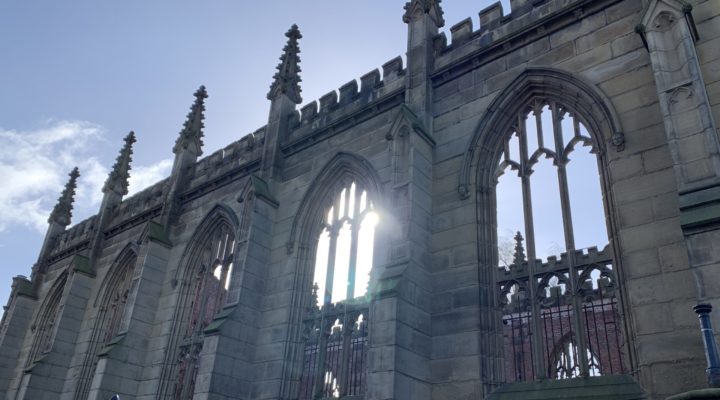Our current virus pandemic has forced all of us to face some harsh realities. One of the benefits of experiencing a seismic shift in our world is the ensuing time of introspection and the questioning of our assumptions.
Most churches are realizing that the landscape of congregational life has dramatically changed, and we must prepare for a very different world over the course of the coming decade.
 This is not a new idea. Several years ago, I began to talk about resilience as a trait I believed was indispensable for a 21st century church. I found this quality in increasingly short supply among the churches I engaged. Many were, and are, fragile and vulnerable to any number of significant threats: economic, leadership, pandemic, theological, societal.
This is not a new idea. Several years ago, I began to talk about resilience as a trait I believed was indispensable for a 21st century church. I found this quality in increasingly short supply among the churches I engaged. Many were, and are, fragile and vulnerable to any number of significant threats: economic, leadership, pandemic, theological, societal.
Most were plateaued or declining in terms of attendance metrics, many had very shallow financial reserves, the majority were heavily skewed toward an aging congregation and had lost significant groups of middle age and younger members to neighboring churches, especially larger and more focused churches.
Cultivating resilience became a standard stump speech and strategy focus for me. Nearly always, heads would quickly nod in agreement with that thesis, but most churches balked at engaging in the sorts of major changes that would be required to move from simply surviving to genuinely thriving.
Now, as we navigate the unknowns before us, I was struck by comments from my friend Seth Hix, who identified some general attitudes and expectation patterns he sees emerging among churches and clergy in this pandemic age. Perhaps identifying our expectations for the future could help us thoughtfully engage our options.
Some want to restart their congregational life as soon as possible. This approach to the future church seeks to resume life as we knew it, and to do so quickly. The underlying assumption is that when we restart what we were doing prior to March 2020, people will return and resume the same ministry model that was in place prior to the pandemic.
It’s understandable and appropriate to long for the security of the familiar patterns that guided our life for decades. Regular in-person worship events, the liturgy, a fine facility that became synonymous with “doing church,” dependable and predictable staff interactions, a warm and welcoming small group experience, regular events for our children, mission trips and fellowship meals — all these describe what we can’t wait to restart and resume.
“It is beginning to dawn on us that what was may never fully return and that we may have been overestimating its effectiveness all along.”
Unfortunately, it is beginning to dawn on us that what was may never fully return and that we may have been overestimating its effectiveness all along.
For example, even in our limited formats, people are not flocking back to worship together. Most churches I talk with have experienced only about a quarter to a third of their previous attenders coming back to worship this summer. While many of the others are justifiably wary of any public gathering, I sense there is a sizable group who are realizing that virtual worship can substitute in many ways for onsite worship. (Personally, I find it a very poor substitute, but many would not agree with me.)
They also are finding their congregants simply don’t miss the times together. As someone recently confided in me: “There was always too much drama, too many conflicts, too much self-absorption for me. I’m not sure I’ll be going back to that.” Another key lay leader in a church confessed: “I now realize we were playing church, not really being church. I’m not interested in resuming that.”
This restart expectation is based more on wishful thinking than honest evaluation.
Some plan simply to refresh their approach to ministry. For these, the pandemic has been a painful but helpful opportunity to do some cleanup work and minor touchup work on church structures and programming. Online education, fellowship and worship offerings have revealed the potential for broadening the reach and impact of what we assumed had to be done in person or on site. The pandemic has given us permission to experiment, and we have done so, but primarily in renovating what already existed. Worship, age-group ministries, small group offerings have been retrofitted to fit a virtual environment.
Again, the underlying message seems to be that while churches will certainly continue to offer virtual options in the future, our primary structures will revert back to pre-pandemic patterns as the main focus as soon as feasible. Like a home renovation that paints over old wallpaper and perhaps replaces a few fixtures, we expect this season of renovation to allow us to emerge from the pandemic looking better, but very similar to how we appeared pre-virus.
This may be an effective short-term strategy and may make us feel better about our capacity for adaptive change, but I suspect it may fail us long-term. In fact, if history holds, most of our technical changes will wither rather quickly and need to be refreshed again as soon as the next crisis hits our churches.
The wise among us are talking about the need to relaunch congregational life for the 2020 decade. As I write these words, I have to confess that I do not actually know what I am saying. I just sense that a whole new thing is emerging and that we will need to consider a “start over” if we are to find the resilience we so desperately need.
Few would argue that the American church of the last 50 years has been compromised by the consumeristic, self-absorbed culture in which we exist. A watered-down faith, Americanized gospel and lip service to humility and service as a way of life have made us irrelevant and weak.
“Some are beginning to see the pandemic as an opportunity for major upheaval and a fresh start as God’s people.”
Some are beginning to see the pandemic as an opportunity for major upheaval and a fresh start as God’s people. This is a narrow and treacherous path, as it will threaten our foundational beliefs about how to do and be a church. It will find its inspiration in cultures where the gospel witness has been subject to persecution, rather than being privy to power, prestige and popular support. See the Christians in China, the former Soviet Union, much of Africa.
Those who choose to relaunch their church or ministry will certainly do so with a smaller, yet more focused group of congregants. Perhaps their biblical inspiration will be the pruning narratives of Jesus that promise more bountiful fruit on the other side of the pain of pruning away what does not produce fruit. Another might be the deeper soil in which the gospel can take root and find the resources to weather the harsh conditions above ground.
Most likely, every church will be a mix of all three of these possible futures. Ministers and lay leaders will find themselves managing intense conversations and painful deliberations among these factions. It will be slow, deliberate and uncomfortable work as we break up the hard ground on which we have built our church home for decades.
Hopefully, that broken ground will become the rich soil from which will spring a more relevant, viable and resilient church.
Bill Wilson is director of The Center for Healthy Churches in Winston-Salem, N.C., and a member of the Baptist News Global board of directors.


